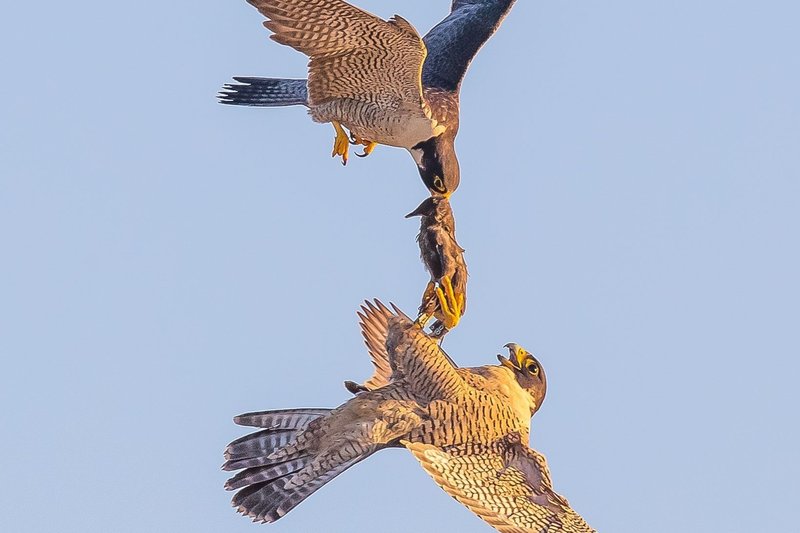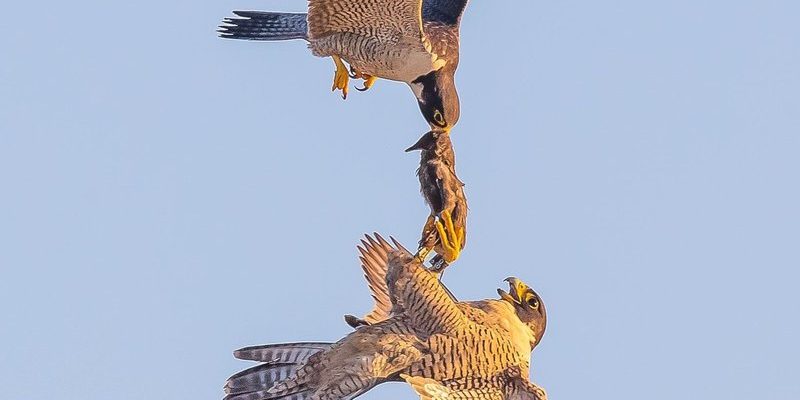
Peregrine falcons are known as the fastest birds on the planet, reaching speeds of over 240 mph when diving for their prey. But what do they actually eat, and how do they catch their meals? Understanding their diet and hunting strategies offers a glimpse into their fascinating lives and their role in the ecosystem. Let me explain how these remarkable birds manage to soar through the skies and swoop down on unsuspecting dinner.
Peregrine Falcon Diet Overview
The peregrine falcon has a varied diet, primarily focused on birds, but they’re not picky eaters. They’re known to hunt small to medium-sized birds, which make up the bulk of their meals. Think of them as the ultimate avian snackers, targeting anything from sparrows to pigeons. But their appetite doesn’t stop there. They also include:
- Shorebirds
- Waterfowl
- Small mammals when necessary
Here’s the thing: their diet can vary significantly depending on their habitat and what’s available. In urban areas, peregrines often feast on city-dwelling birds like starlings and pigeons, while in more rural settings, they might target smaller songbirds that are abundant in the area. This ability to adapt their diet is crucial for their survival across different environments.
Feeling the Speed: How They Hunt
The hunting strategy of the peregrine falcon is nothing short of spectacular and can be broken down into a series of thrilling steps. First, these birds rely heavily on their incredible eyesight, which allows them to spot their prey from a great distance. Imagine having eyes that can see four to eight times further than a human’s! They can pick out small birds even while soaring hundreds of feet in the air.
Once they’ve zeroed in on their target, they enter a high-speed dive called a “stoop.” Here’s where the magic happens: they fold their wings against their bodies, transforming into a guided missile that can reach astonishing speeds. During this phase, the peregrine uses both speed and precision to catch its prey off guard. Honestly, it’s like watching a well-oiled machine in action.
Adaptations for Success
Peregrine falcons have developed several adaptations that make them superb hunters. Their sharp, hooked beaks are perfect for tearing flesh, and their talons are designed for gripping their prey tightly. Just picture a pair of grappling hooks, ready to snare anything they catch.
Another fascinating adaptation is their unique respiratory system. When they dive at such high speeds, their bodies have developed specialized structures that protect their lungs from the sudden increase in air pressure. This means they can hunt without worrying about injury, giving them a significant advantage in the wild.
The Role of Location in Hunting
The hunting success of peregrine falcons can also depend on where they live. Urban environments often provide ample food sources thanks to the abundance of birds in cities. However, hunting in these areas comes with its own challenges, like dodging buildings and other obstacles. You might be wondering how they handle those tricky situations.
They often choose tall structures, like skyscrapers or cliffs, as vantage points. From these heights, they can scan the ground below for potential meals. This strategy is similar to how a sniper uses higher ground to gain a better line of sight. By doing this, peregrine falcons minimize their chances of being surprised by their own prey while maximizing their hunting efficiency.
Impact of Seasons on Diet
Peregrine falcons also adjust their diet based on seasonal changes. During migration seasons, you’ll find different species of birds passing through their territory. This tapping into seasonal opportunities caters to their dietary needs and helps them maintain energy levels during the long flights.
For instance, in spring and summer, they often target fledgling birds that are just learning to fly. These young birds are typically easier to catch than their more experienced counterparts. In contrast, during fall and winter, they may rely more heavily on resident birds, which can sometimes lead to tougher hunting conditions.
Conservation Status and Challenges
Despite their incredible skills, peregrine falcons faced significant challenges in the past, primarily due to habitat loss and pesticide use, particularly DDT. This chemical caused their eggshells to thin, leading to reproductive failure. However, thanks to concerted conservation efforts, their numbers have rebounded significantly. Honestly, it’s a remarkable success story in wildlife conservation!
Today, peregrine falcons are protected under various laws and are even found flourishing in urban environments. But they still face threats from habitat destruction and climate change. It’s essential to continue supporting conservation efforts to ensure these extraordinary birds thrive for generations to come.
Final Thoughts on the Peregrine Falcon
The diet and hunting strategies of the peregrine falcon reveal much about their adaptability, skill, and role in nature. From their remarkable speed to their keen eyesight, these birds are a testament to the wonders of evolution. As we continue to understand and appreciate their lives, we must also be vigilant in conserving their habitats. After all, each time we witness a peregrine falcon soaring through the sky, we’re not just seeing a bird; we’re witnessing nature’s masterpiece in action. So next time you look up and see one, remember the incredible journey it took to get there!

